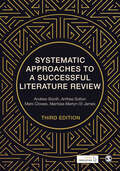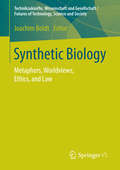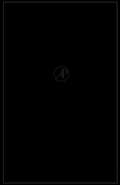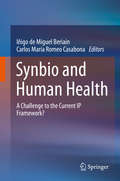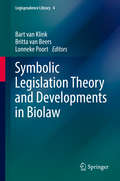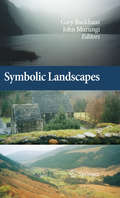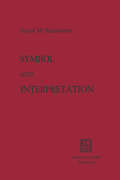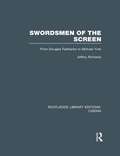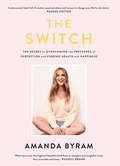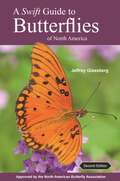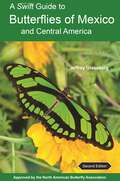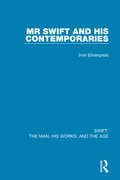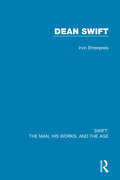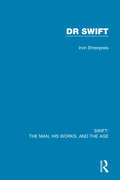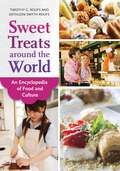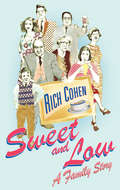- Table View
- List View
Systematic Approaches to a Successful Literature Review
by Andrew Booth Anthea Sutton Mark Clowes Marrissa Martyn-St JamesWhether you are new to literature reviews or working with new types of data, this book takes the guesswork out of writing your literature review. From deciding how much literature to include to managing your data, assessing your sources, and writing results, it outlines a step-by-step process that works with any data. To help you choose best approach for your research, this book includes: · Worksheets and decision aids to help you plan and organise your literature review · Worked examples and case studies to show you what – and what not – to do in practice · Troubleshooting tips and answers to all your frequently asked questions · Online access to a literature review starter template, an exercise workbook, project diary template, and a source credibility checklist. The perfect project support for any social sciences student, this edition also includes a new chapter on analysing mixed methods research.
Systematic Approaches to a Successful Literature Review
by Andrew Booth Anthea Sutton Mark Clowes Marrissa Martyn-St JamesWhether you are new to literature reviews or working with new types of data, this book takes the guesswork out of writing your literature review. From deciding how much literature to include to managing your data, assessing your sources, and writing results, it outlines a step-by-step process that works with any data. To help you choose best approach for your research, this book includes: · Worksheets and decision aids to help you plan and organise your literature review · Worked examples and case studies to show you what – and what not – to do in practice · Troubleshooting tips and answers to all your frequently asked questions · Online access to a literature review starter template, an exercise workbook, project diary template, and a source credibility checklist. The perfect project support for any social sciences student, this edition also includes a new chapter on analysing mixed methods research.
Systematic Approaches to a Successful Literature Review
by Andrew Booth Anthea Sutton Mark Clowes Marrissa Martyn-St JamesWhether you are new to literature reviews or working with new types of data, this book takes the guesswork out of writing your literature review. From deciding how much literature to include to managing your data, assessing your sources, and writing results, it outlines a step-by-step process that works with any data. To help you choose best approach for your research, this book includes: · Worksheets and decision aids to help you plan and organise your literature review · Worked examples and case studies to show you what – and what not – to do in practice · Troubleshooting tips and answers to all your frequently asked questions · Online access to a literature review starter template, an exercise workbook, project diary template, and a source credibility checklist. The perfect project support for any social sciences student, this edition also includes a new chapter on analysing mixed methods research.
Systematic Approaches to a Successful Literature Review
by Andrew Booth Anthea Sutton Diana PapaioannouShowing you how to take a structured and organized approach to a wide range of literature review types, this book helps you to choose which approach is right for your research. Packed with constructive tools, examples, case studies and hands-on exercises, the book covers the full range of literature review techniques. New to This Edition: Full re-organization takes you step-by-step through the process from beginning to end New chapter showing you how to choose the right method for your project Practical guidance on integrating qualitative and quantitative data New coverage of rapid reviews Comprehensive inclusion of literature review tools, including concept analysis, scoping and mapping With an emphasis on the practical skills, this guide is essential for any student or researcher needing to get from first steps to a successful literature review.
Synthetic Biology: Metaphors, Worldviews, Ethics, and Law (Technikzukünfte, Wissenschaft und Gesellschaft / Futures of Technology, Science and Society)
by Joachim BoldtAssessing synthetic biology from a societal and ethical perspective is not only a matter of determining possible harms and benefits of synthetic biology applications. Synthetic biology also incorporates a specific technoscientific understanding of its research agenda and its research objects that has philosophical and ethical implications. This edited volume sets out to explore and evaluate these synthetic biology worldviews and it proposes appropriate governance measures. In addition, legal challenges are discussed.
A Syntax-Oriented Translator
by Peter Zilahy IngermanA Syntax-Oriented Translator focuses on the field of programming and the characteristics and functions of compilers and translators.The book first offers information on the metasyntactic language and the details of a parsing processor. Discussions focus on processing, recovery, and output sections, detailed flow-chart of the parsing processor, parsing form of a grammar, canonical ordering, and the metasyntactic language in general. The text then elaborates on some extensions to the metasyntactic language and metasemantic and metapragmatic language, including punctuation marks and format control, metasemantic and metapragmatic functions, basic form of the construct, and substitution MSF. The publication examines the details of an unparsing processor, as well as lists used in unparsing, subroutines, and the unparsing processor itself. The book is a dependable source of information for home compiler-writers who are interested in the use of a syntax-oriented translator.
Synbio and Human Health: A Challenge to the Current IP Framework?
by Iñigo Miguel Beriain Carlos María Romeo CasabonaSince 2010, the Inter-university chair in law and the Human Genome has been involved in an EU 7th Framework Programme funded Project called Sybhel, leading work package 5. The aim of this work package was to face the issues related to synthetic biology and intellectual property rights. In these years, the Chair organized two international workshops devoted to this topic, collecting a number of high level unpublished papers redacted by some of the most prominent experts in this field worldwide, including Stephen Maurer, Joachim Henkel, Ingrid Schneider, etc. We consider that it would be extremely interesting to have them all gathered in a unique contributed volume, which would be the first book exclusively dedicated to analyze the implications that Synbio may involve in what refers to the currently existing intellectual property rights system.
Symbols & Trademarks (Tactile)
by Adrian FarnsworthThis is a four-page document showing commonly-used symbols and trademarks. There are four on page one, three on each of pages two and three, and two on page four. The Woolmark on page two is a registered trade mark of The Woolmark Company and the Golden Arches logo on page four is a registered trade mark of the McDonald's Corporation.
Symbolic Legislation Theory and Developments in Biolaw (Legisprudence Library #4)
by Bart Van Klink Britta Van Beers Lonneke PoortThis edited volume covers new ground by bringing together perspectives from symbolic legislation theory on the one hand, and from biolaw and bioethics on the other hand. Symbolic legislation has a bad name. It usually refers to instances of legislation which are ineffective and that serve other political and social goals than the goals officially stated. Recently, a more positive notion of symbolic legislation has emerged in legislative theory. From this perspective, symbolic legislation is regarded as a positive alternative to the more traditional, top-down legislative approach. The legislature no longer merely issues commands backed up with severe sanctions, as in instrumental legislation. Instead, lawmakers provide open and aspirational norms that are meant to change behavior not by means of threat, but indirectly, through debate and social interaction. Since the 1990s, biomedical developments have revived discussions on symbolic legislation. One of the reasons is that biomedical legislation touches on deep-rooted, symbolic-cultural representations of the biological aspects of human life. Moreover, as it is often impossible to reach consensus on these controversial questions, legislators have sought alternative ways to develop legal frameworks. Consequently, communicative and interactive approaches to legislation are prominent within the governance of medical biotechnology. The symbolic dimensions of biolaw are often overlooked. Yet, it is clear that the symbolic is at the heart of many legal-political debates on bioethical questions. Since the rise of biomedical technologies, human body materials have acquired a scientific, medical and even commercial value. These new approaches, which radically question existing legal symbolizations of the human body, raise the question whether and how the law should continue to reflect symbolic values and meanings. Moreover, how can we decide what these symbolic values are, given the fact that we live in a pluralistic society?
Symbolic Landscapes
by Gary Backhaus John MurungiSymbolic Landscapes presents a definitive collection of landscape/place studies that explores symbolic, cultural levels of geographical meanings. Essays written by philosophers, geographers, architects, social scientists, art historians, and literati, bring specific modes of expertise and perspectives to this transdisciplinary and interdisciplinary study of the symbolic level human existential spatiality. Placing emphasis on the pre-cognitive genesis of symbolic meaning, as well as embodied, experiential (lived) geography, the volume offers a fresh, quasi-phenomenological approach. The editors articulate the epistemological doctrine that perception and imagination form a continuum in which both are always implicated as complements. This approach makes a case for the interrelation of the geography of perception and the geography of imagination, which means that human/cultural geography offers only an abstraction if indeed an aesthetic geography is constituted merely as a sub-field. Human/cultural geography can only approach spatial reality through recognizing the intimate interrelative dialectic between the imaginative and perceptual meanings of our landscapes/place-worlds. This volume reinvigorates the importance of the topic of symbolism in human/cultural geography, landscape studies, philosophy of place, architecture and planning, and will stand among the classics in the field.
Symbol and Interpretation
by D.M. RasmussenFor the past four or five years much of my thinking has centered up on the relationship of symbolic forms to philosophic imagination and interpretation. As one whose own philosophic speculations began at. the end of a cultural epoch under methodologies dominated either by neo-Kantianism or schools of logical empiricism the symbol as a prod uct of a cultural imagination has been diminished; it has been neces sary for those who wanted to preserve the symbol to find appropriate philosophical methodologies to do so. In the following chapters we shall attempt to show, through a consideration of a series of recent interpretations of the symbol, as well as through constructive argu ment, that the symbol ought to be considered as a linguistic form in the sense that it constitutes a special language with its own rubrics and properties. There are two special considerations to be taken ac count of in this argument; first, the definition of the symbol, and sec ond, the interpretation of the symbol. Although we shall refrain from defining the symbol explicitly at this point let it suffice to state that our definition of the symbol is more aesthetic than logical (in the technical sense of formal logic ), more cultural than individual, more imaginative than scientific. The symbol in our view is somewhere at the center of culture, the well-spring which testifies to the human imagination in its poetic, psychic, religious, social and political forms.
Swordsmen of the Screen: From Douglas Fairbanks to Michael York (Routledge Library Editions: Cinema)
by Jeffrey RichardsThis fascinating study of the genre of swashbuckling films received wide critical acclaim when it was first published in 1977. Jeffrey Richards assesses the contributions to the genre of directors, designers and fencing masters, as well as of the stars themselves, and devotes several chapters to the principal subjects if the swashbucklers – pirates, highwaymen, cavaliers and knights. The result is to recall, however fleetingly, the golden days of the silver screen. Reviews of the original edition: ‘An intelligent, scholarly, well-written account of adventure films, this work is sensitive both to cinema history and to the literary origins of the "swashbuckler"….Essential for any library with books on film, it may very well be the definitive book on its subject.’ – Library Journal
Swordsmen of the Screen: From Douglas Fairbanks to Michael York (Routledge Library Editions: Cinema)
by Jeffrey RichardsThis fascinating study of the genre of swashbuckling films received wide critical acclaim when it was first published in 1977. Jeffrey Richards assesses the contributions to the genre of directors, designers and fencing masters, as well as of the stars themselves, and devotes several chapters to the principal subjects if the swashbucklers – pirates, highwaymen, cavaliers and knights. The result is to recall, however fleetingly, the golden days of the silver screen. Reviews of the original edition: ‘An intelligent, scholarly, well-written account of adventure films, this work is sensitive both to cinema history and to the literary origins of the "swashbuckler"….Essential for any library with books on film, it may very well be the definitive book on its subject.’ – Library Journal
The Switch: The Secret to Overcoming the Pressures of Perfection and Finding Health and Happiness
by Amanda ByramA phenomenal book full of wisdom, practical advice and humour to change your life for the better.’FEARNE COTTON – Broadcaster, bestselling author and mental health champion‘What a personal, thorough and beautiful book from an energetic and insightful writer. Very accessible and funny.’ RUSSELL BRAND – Author, broadcaster, actor, podcaster, columnist and mental health & drug rehabilitation activist At 47, Amanda Byram is in the shape of her life, both mentally and physically. But for over two decades she was trapped in a cycle of yo-yo dieting and self-criticism, convinced that unless she was ‘perfect’ she wouldn’t be happy or worthy. By the time she reached her fortieth birthday, she was exhausted … something had to change.The Switch is a distillation of all the simple and life-changing techniques, tips and tricks she used to get herself off the ‘perfection treadmill’ once and for all. She shares how to silence the critical internal voices that hold us back, and how to ditch diets for good and eat and exercise in a way that will give you power, not problems.Switch to a balanced lifestyle where food, fitness, family, friends and self-care are all in sync and discover the happiest and healthiest version of yourself.‘Amanda is a master of emotional reinvention. Using her own experiences and Switch method she has helped, guided and supported both those very close to her and those she has never even met. Amanda has never been afraid to break down the stigmas of mental health, using her generosity, honesty and wit.’ Gok Wan – Broadcaster and mental health ambassador'The Switch is a powerful reminder that being kind to yourself is the first step toward improving your health, both mental and physical. Thorough, thought-provoking, and immensely helpful for anyone who wants to make a positive change in their life – not just their body. I loved it!' Sarah Knight – Bestselling author of the No F*cks Given Guides'For anyone serious about making the switch to a healthier mind and body, this book is an absolute gem. It’s packed full of wisdom, insight and clinically evidenced guidance. Definitely a lifetime companion.' Owen O'Kane – Bestselling self-help author and psychotherapist
A Swift Guide to Butterflies of North America: Second Edition (PDF)
by Jeffrey GlassbergA thoroughly revised edition of the most comprehensive and authoritative photographic field guide to North American butterfliesThis is a revised second edition of the most detailed, comprehensive, and user-friendly photographic field guide to the butterflies of North America. Written by Jeffrey Glassberg, the pioneering authority on the field identification of butterflies, the guide covers all known species, beautifully illustrating them with 3,500 large, gorgeous color photographs—the very best images available. This second edition includes more than 500 new photos and updated text, maps, and species names. For most species, there are photographs of topsides and undersides, males and females, and variants. All text is embedded in the photographs, allowing swift access in the field, and arrows point to field marks, showing you exactly what to look for. Detailed, same-page range maps include information about the number of broods in each area and where strays have been recorded. Color text boxes highlight information about habitat, caterpillar food plants, abundance and flight period, and other interesting facts. Also included are a quick visual index and a caterpillar food plant index. The result is an ideal field guide that will enable you to identify almost every butterfly you see.A revised second edition of the most comprehensive photographic field guide to North American butterflies, featuring more than 500 new photos and updated text, maps, and species namesWritten by the pioneering authority on the field identification of butterfliesBeautifully illustrated with 3,500 color photographs that show all known species, including views of topsides and undersides, males and females, and variants for most speciesAuthoritative text embedded in the photographs for swift accessDetailed range mapsColor text boxes that highlight information about habitat, food plants, abundance and flight period, and other interesting factsAn invaluable tool for field identification
A Swift Guide to Butterflies of Mexico and Central America: Second Edition
by Jeffrey GlassbergA groundbreaking photographic field guide to almost all of Mexico's butterfly species and many of Central America'sThis is a revised second edition of a groundbreaking photographic field guide to the butterflies of Mexico and Central America. Written by Jeffrey Glassberg, the pioneering authority on the field identification of butterflies, the guide covers more than 2,000 species and features over 3,700 large, gorgeous color photographs, the very best images available, accompanied by authoritative facing-page text. This second edition includes more species, more than 1,500 new photos, and updated text, maps, and species names. And range maps, field marks, and host plants are included for all Mexican butterflies. The result is an ideal field guide that will enable you to identify almost every butterfly you see.A revised second edition of a groundbreaking guide, featuring more species, more than 1,500 new photos, and updated text, maps, and species namesThe first complete guide to Mexican butterfliesCovers almost all of Mexico's more than 1,700 species, plus many Central American species, including more than two-thirds of those in Costa RicaWritten by the pioneering authority on the field identification of butterfliesBeautifully illustrated with more than 3,700 color photographs that highlight key identification featuresRange maps, field marks, and host plants for all Mexican speciesAuthoritative facing-page textAn invaluable tool for field identification
Swift: Volume One: Mr Swift and his Contemporaries (Swift: The Man, his Works, and the Age)
by Irvin EhrenpreisFirst published in 1962, Mr Swift and his Contemporaries, is the first of three volumes providing a detailed exploration of the events of Swift’s life. This volume is a thorough insight into the historical and social setting of Swift’s life, the evolution of his character, and the composition and interpretation of his works. It includes a wealth of material concerning Swift’s family and career, his emotional and sexual life, his relationship with Sir William Temple, and the design and meaning of both A Tale of a Tub and The Battle of the Books. Mr Swift and his Contemporaries is ideal for anyone with an interest in Swift’s life, work, and the period in which he lived.
Swift: Volume Three: Dean Swift (Swift: The Man, his Works, and the Age)
by Irvin EhrenpreisFirst published in 1983, Dean Swift is the concluding book in a series of three volumes providing a detailed exploration of the events of Swift’s life. The third volume follows Swift’s life and career from 1714 to 1745 and sets it against the public events of the age, paying close attention to political and economic change, ecclesiastical problems, social issues, and literary history. It traces Swift’s rise to becoming first citizen of Ireland and looks in detail at the composition, publication, and reception of Gulliver’s Travels, as well as many of Swift’s other works, both poetry and prose. It also explores Swift’s later years, his love affairs with Esther Johnson and Esther Vanhomrigh, his complicated friendships with Pope, Lord Bolingbroke, and Archbishop King, and his declining health. Dean Swift is a hugely detailed insight into Swift’s life from 1714 until his death and will be of interest to anyone wanting to find out more about his life and works.
Swift: Volume Two: Dr Swift (Swift: The Man, his Works, and the Age)
by Irvin EhrenpreisFirst published in 1967, Dr Swift is the second of three volumes providing a detailed exploration of the events of Swift’s life. This volume begins by assessing Swift’s character, hopes and ambitions in 1699. It then traces his life and career up to 1714 in minute detail, giving close consideration to Swift’s expectations and the extent to which he felt they were fulfilled. In doing so, it covers Swift’s movement between Ireland and England, his reputation as a poet, his historical writing, his church preferments, involvement in politics, and much more, including his relationships with a number of prominent social figures of the time. Dr Swift is ideal for those with an interest in Swift’s life, and in particular his life and career between 1699 and 1714.
Swift: Volume Three: Dean Swift (Swift: The Man, his Works, and the Age)
by Irvin EhrenpreisFirst published in 1983, Dean Swift is the concluding book in a series of three volumes providing a detailed exploration of the events of Swift’s life. The third volume follows Swift’s life and career from 1714 to 1745 and sets it against the public events of the age, paying close attention to political and economic change, ecclesiastical problems, social issues, and literary history. It traces Swift’s rise to becoming first citizen of Ireland and looks in detail at the composition, publication, and reception of Gulliver’s Travels, as well as many of Swift’s other works, both poetry and prose. It also explores Swift’s later years, his love affairs with Esther Johnson and Esther Vanhomrigh, his complicated friendships with Pope, Lord Bolingbroke, and Archbishop King, and his declining health. Dean Swift is a hugely detailed insight into Swift’s life from 1714 until his death and will be of interest to anyone wanting to find out more about his life and works.
Swift: Volume One: Mr Swift and his Contemporaries (Swift: The Man, his Works, and the Age)
by Irvin EhrenpreisFirst published in 1962, Mr Swift and his Contemporaries, is the first of three volumes providing a detailed exploration of the events of Swift’s life. This volume is a thorough insight into the historical and social setting of Swift’s life, the evolution of his character, and the composition and interpretation of his works. It includes a wealth of material concerning Swift’s family and career, his emotional and sexual life, his relationship with Sir William Temple, and the design and meaning of both A Tale of a Tub and The Battle of the Books. Mr Swift and his Contemporaries is ideal for anyone with an interest in Swift’s life, work, and the period in which he lived.
Swift: Volume Two: Dr Swift (Swift: The Man, his Works, and the Age)
by Irvin EhrenpreisFirst published in 1967, Dr Swift is the second of three volumes providing a detailed exploration of the events of Swift’s life. This volume begins by assessing Swift’s character, hopes and ambitions in 1699. It then traces his life and career up to 1714 in minute detail, giving close consideration to Swift’s expectations and the extent to which he felt they were fulfilled. In doing so, it covers Swift’s movement between Ireland and England, his reputation as a poet, his historical writing, his church preferments, involvement in politics, and much more, including his relationships with a number of prominent social figures of the time. Dr Swift is ideal for those with an interest in Swift’s life, and in particular his life and career between 1699 and 1714.
Sweet Treats around the World: An Encyclopedia of Food and Culture
by Timothy G. Roufs Kathleen Smyth RoufsFrom apple pie to baklava, cannoli to gulab jamun, sweet treats have universal appeal in countries around the world. This encyclopedia provides a comprehensive look at global dessert culture.Few things represent a culture as well as food. Because sweets are universal foods, they are the perfect basis for a comparative study of the intersection of history, geography, social class, religion, politics, and other key aspects of life. With that in mind, this encyclopedia surveys nearly 100 countries, examining their characteristic sweet treats from an anthropological perspective. It offers historical context on what sweets are popular where and why and emphasizes the cross-cultural insights those sweets present. The reference opens with an overview of general trends in desserts and sweet treats. Entries organized by country and region describe cultural attributes of local desserts, how and when sweets are enjoyed, and any ingredients that are iconic. Several popular desserts are discussed within each entry including information on their history, their importance, and regional/cultural variations on preparation. An appendix of recipes provides instructions on how to make many of the dishes, whether for school projects or general entertaining.
Sweet Treats around the World: An Encyclopedia of Food and Culture
by Timothy G. Roufs Kathleen Smyth RoufsFrom apple pie to baklava, cannoli to gulab jamun, sweet treats have universal appeal in countries around the world. This encyclopedia provides a comprehensive look at global dessert culture.Few things represent a culture as well as food. Because sweets are universal foods, they are the perfect basis for a comparative study of the intersection of history, geography, social class, religion, politics, and other key aspects of life. With that in mind, this encyclopedia surveys nearly 100 countries, examining their characteristic sweet treats from an anthropological perspective. It offers historical context on what sweets are popular where and why and emphasizes the cross-cultural insights those sweets present. The reference opens with an overview of general trends in desserts and sweet treats. Entries organized by country and region describe cultural attributes of local desserts, how and when sweets are enjoyed, and any ingredients that are iconic. Several popular desserts are discussed within each entry including information on their history, their importance, and regional/cultural variations on preparation. An appendix of recipes provides instructions on how to make many of the dishes, whether for school projects or general entertaining.
Sweet and Low: A Family Story
by Rich CohenRich Cohen's maternal grandfather was called Ben Eisenstadt. Ben was one of those Jews that, with an anger bred of exclusion, went on to reshape the world. He did so by inventing Sweet 'n Low, a granulated sweetener which, in its tiny pink packet, is still found on every table in every diner in America. This simple invention spawned one of the great American fortunes. This is the story of that fortune, how it was made and how it remade and tore apart everyone who touched it.In Sweet and Low, Rich Cohen - the youngest son of Ben's favourite daughter - takes a journey into his own and his family's past. It is a story of family feuds (his mother was eventually disinherited by her mother), eccentricity verging on madness, gangsters, lawyers, corruption, accountants, ex-wives - a quest for a secret history, a black comedy of the American dream.
